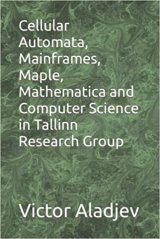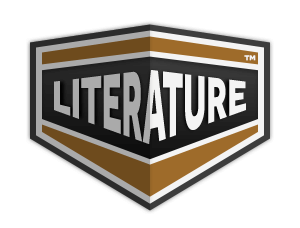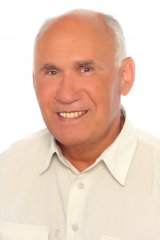
The book presents an expanded excursion into the creative activities of the Tallinn Research Group during 1970–2022 with a focus on researches and development in such main fields as mainframes, personal computers, general statistics theory, issues of parallel information processing and computing, computer mathematics systems (Maple, Mathematica), programming, automated control systems, mathematical developmental biology, some mathematical problems in the cellular automata theory with a focus on our standpoint on the main stages of formation of the cellular automata theory. The book may be of certain interest as a retrospective standpoint on development of the above areas in the USSR (primarily in the ESSR) and the republics of the former USSR. The book is equipped with a fairly extensive bibliography on the issues under consideration.
- Year:
- 2022
- 633 Views
Submitted by
aladjev on April 20, 2022
INTRODUCTION
CHAPTER 1:
Mainframes and
Personal Computers
1.1.
System and
applied programming on mainframes
1.2.
System and
applied programming on
personal computers
1.3.
Special courses and
books edition on computers
CHAPTER 2:
Computer Mathematics Systems
2.1.
Background of
interest in
these issues
2.2.
Computer mathematics
system Mathematica
2.3.
Computer mathematics
system Maple
CHAPTER 3:
Mathematical Developmental Biology
3.1.
General prerequisites
3.2.
Discrete modeling in
developmental biology
3.3. The
French Flag Problem
3.4. The
Limited Growth Problem
CHAPTER 4:
Certain Mathematical Problems
4.1. The H.
Steinhaus combinatorial problem
4.2. The S. Ulam
problem from
number theory
4.3. An
algebraic system for
polynomial representation of the a–valued
logical functions
CHAPTER 5:
Cellular Automata (Homogeneous Structures)
5.1.
Basic concepts of
classical cellular automata
5.2. The nonсonstructability
problem in
classical cellular automata
5.3.
Extreme design
capabilities of
classical cellular automata
5.4. The
complexity problem of
finite configurations in
classical cellular automata
5.5.
Parallel formal
grammars and
languages defined by the
classical cellular
automata (CA–models)
5.6.
Modeling problem in
classical cellular
automata and
certain related issues
5.7. The
decomposition problem of
global transition
functions in
classical cellular
automata (CA–models)
5.8. The main
stages of
cellular automata
theory formation
CONCLUSION
REFERENCES
ABOUT
THE AUTHOR
Victor Aladjev
Aladjev Victor Zakharovich – President of the Baltic Branch of the International Academy of Noosphere, Prof., DSc in Mathematics. He was born on June 14, 1942 in Grodno and was baptized on July 14, 1942 in the Farny catholic Church in Grodno (West Belarus). In 1959 he entered the first year of the Physics and Mathematics Faculty of the University of Grodno, and in 1962 he was transferred to the Mathematics Department of the University of Tartu (Estonia), which he successfully graduated in 1966 with a degree in Mathematics. In 1969 Aladjev entered the graduate school of the Academy of Sciences of the ESSR with a degree in Theory of Probability and Mathematical Statistics, which successfully graduated in 1972 in two specialties at once, Theoretical Cybernetics and Technical Cybernetics. In 1972 he was awarded a doctorate in mathematics (DSc) from Prof. R. Bellman (USA) for his work “Mathematical Theory of the Homogenious Structures and Their Applications”; the given work was recognized as the best in the Academy Sciences of the ESSR at 1972. Since 1970, Aladjev V. – President of the Tallinn Research Group (TRG) organized by him, whose scientific results subsequently have received certain international recognition, primarily in the field of researches on the mathematical theory of homogeneous structures (Cellular Automata). Cellular automata (CAs), initially being the root cause of the formation of the TRG, over time became a less significant field of scientifical and applied activity of the Group, inferior to more priority fields, in particular computer mathematics systems, although quite often interest in the CAs problematics arose again for particular periods of duration; however, the intensity of researches in this direction also decreased over time.
In 1972, V. Aladyev published the first monograph on the homogeneous structures theory in the USSR, which was recognized as one of the best monographical publication of the Estonian Academy of Sciences in the same year, and in 1977 was noted in Soviet Mathematical Encyclopedia and in Encyclopaedia of Physical Science and Technology. The monograph not only presented a number of original results on this problematics, but introduced the basic Russian–language terminology on cellular automata too, which is now generally accepted.
From 1972 up to 1990, he held senior positions (chief engineer, deputy director for science) in a number of design, technological and research organizations in Tallinn (Estonia). Aladjev’s activities at these posts were repeatedly awarded and prizes by the Council of Ministers of the USSR, the Central statistics Committee of the USSR, the All–Union Project and Tecnological Institute of the Central Statistics Committee of the USSR, etc. Prof. V.Z. Aladjev is the basic author more than 500 scientific and scientific and technical works (including 90 monographs, textbooks and collections of articles) published in the USSR, Russia, Germany, Belarus, Estonia, Lithuania, Ukraine, the GDR, Czechoslovakia, Hungary, Japan, the USA, Holland, Bulgaria and Great Britain. Since 1972, he is referent and member of editorial board of the international mathematical journal “Zentralblatt für Mathematik” and since 1980, he is a member of IAMM (International Accociation on Mathematical Modelling). Prof. V. Aladjev is a member of the editorial boards of a number of scientific journals. He created the Estonian School for the mathematical theory of homogeneous structures, whose fundamental results received international recognition and have made certain contributions in the basis of a new division of the modern mathematical cybernetics. A lot of applied works of Aladjev V.Z. refers to computer science among which it is worth noting widely known textbooks on computer mathematics systems. Along with these original editions, he developed a large UserLib6789 library of new software tools (more than 850) for which he was won the Smart Award network award, and a large unified MathToolBox package (more 1420 tools) for Maple and Mathematica systems, respectively, which rather essentially expand the functionality of these systems. During the preparation of these books and creation of software tools for the Maple and Mathematica systems, a sufficiently wide range of the proposals for organization, functioning and set of standard tools that improve both systems was registered, certain of which were subsequently included in subsequent versions of the systems.
In a number of fields (mathematics, computer science, cellular automata, mathematical packages, etc.) Aladjev V.Z. collaborates with a number of universities in the CIS under the program “Visiting Professor”. As a part of the given program and in the process of preparing a series of books on Maple and Mathematica systems, Aladjev V. for a lot of years gave cycles of lectures on these systems for students, graduate students and teachers of the universities of the Baltic States and Belarus, which became rather famous. more…
All Victor Aladjev books




Discuss this Cellular Automata, Mainframes, Maple, Mathematica and Computer Science in Tallinn Research Group book with the community:
Report Comment
We're doing our best to make sure our content is useful, accurate and safe.
If by any chance you spot an inappropriate comment while navigating through our website please use this form to let us know, and we'll take care of it shortly.
Attachment
You need to be logged in to favorite.
Log In